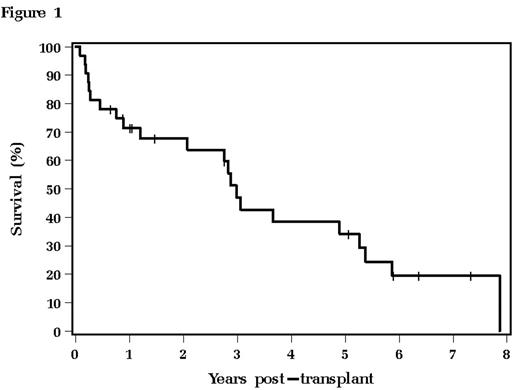Abstract
The role of high dose therapy and autologous stem cell transplantation (ASCT) for patients with peripheral T-cell lymphoma (PTCL) is poorly defined. Comparisons of outcomes between PTCL and B-cell NHL following HDT have yielded conflicting results, in part due to the rarity and heterogeneity of PTCL. Older retrospective studies found comparable survival rates after ASCT for pts with T-cell and B-cell NHL.1,2 In this study, we report our single center experience over one decade using a uniform high-dose regimen for patients with PTCL.
Patients and Methods
The transplant database of the BMT program at Cleveland Clinic was reviewed, and 32 patients undergoing ASCT for PTCL between 1996 and 2005 were identified. Twenty-one patients (66%) had anaplastic large cell lymphoma (ALCL), and 11 (34%) had peripheral T cell, not otherwise specified (PTCL-NOS). Patient characteristics are summarized in table 1.
Stem cell mobilization with VP16 and GCSF priming provided a median CD34 cell dose of 5.01× 106/kg (range 2.05–29.69). Patients received a preparative regimen consisting of busulfan (either 1 mg/kg orally or 0.8mg/kg IV for 14 doses), followed by VP16 60 mg/kg IV continuous infusion, then cyclophosphamide 60mg/m2 IV daily for two days. Standard supportive care measures were employed.
Results
Recovery to 500 neutrophils/uL occurred at a median of 10 days post transplant (range 9–12 days) and platelet recovery to 20 000 at a median of 14 (range 7–60) days.
Kaplan-Meier 5 year overall survival and relapse-free survival for all patients is 34% and 18%, respectively; median survival for all patients is 36 months (see figure 1). Median follow-up of 10 survivors is 25 months. No obvious plateau was observed on the overall or relapse fee survival curves. No significant difference in outcomes based on subgroup (ALCL versus PTCL-NOS) was observed. Staining for anaplastic lymphoma kinase (ALK) was available for 11 (of 21 total) anaplastic T cell lymphoma patients: 4/5 ALK-positive patients are alive compared to 2/6 ALK-negative patients at last follow-up. Four of five patients undergoing ASCT as consolidation following initial therapy are alive at a median 25 months.
Based on this small patient population, and in contrast to some recent studies, our results suggest a poor outcome for patients with PTCL after ASCT. The outcome for pts undergoing ASCT in first remission, and for ALK-positive (versus ALK-negative) ALCL, requires prospective investigation.
Patient Characteristics
| Characteristic . | N (%) . |
|---|---|
| ALCL | 21 (66) |
| PTCL NOS | 11 (34) |
| Male | 21 (66) |
| Age: median(range) | 44 (16-69) |
| 2 prior chemo regimens | 22 (69) |
| 3 or more prior chemo regimens | 7 (22) |
| Transplant in first remission | 5 (16) |
| Relapsed/Refractory | 25 (78) |
| Characteristic . | N (%) . |
|---|---|
| ALCL | 21 (66) |
| PTCL NOS | 11 (34) |
| Male | 21 (66) |
| Age: median(range) | 44 (16-69) |
| 2 prior chemo regimens | 22 (69) |
| 3 or more prior chemo regimens | 7 (22) |
| Transplant in first remission | 5 (16) |
| Relapsed/Refractory | 25 (78) |
Disclosure: No relevant conflicts of interest to declare.
Author notes
Corresponding author


This feature is available to Subscribers Only
Sign In or Create an Account Close Modal